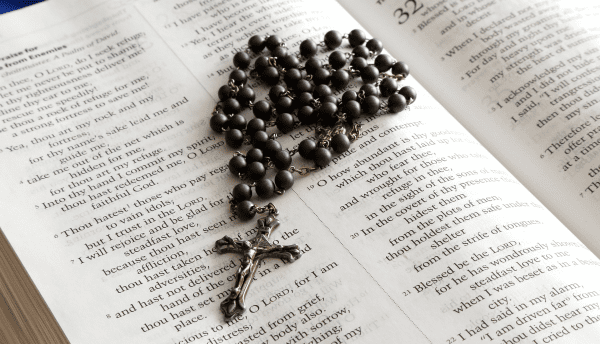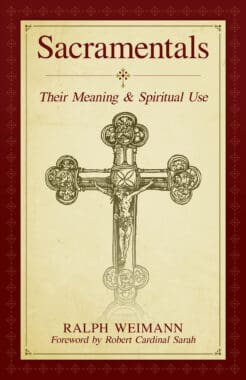In prayer, the Church turns toward Almighty God; accordingly, prayers are part of the Church’s liturgical action. Sacramentals “always include a prayer, often accompanied by a specific sign, such as the laying on of hands, the sign of the cross, or the sprinkling of holy water (which recalls Baptism).” At this point, a first and important characteristic of all sacramentals is evident: Sacramentals are, above all, prayer. They are not private or charismatic prayers; rather, they are a liturgical act and, therefore, a prayer of the Church. In consequence, this type of prayer is part of the whole Church, which includes God Almighty, the wellspring of all graces, but it also includes the angels, the saints, and the people gathered together. Contextualized by all of these elements, the sacramentals draw their strength from the supernatural reality.
This affirmation is important concerning the very structure of the prayers used when sacramentals are administered. For that reason, besides the Most Holy Trinity, saints and angels are invoked, since they are a part—the noblest part—of the Church. “Prayer is Christian insofar as it is communion with Christ and extends throughout the Church, which is his Body. Its dimensions are those of Christ’s love.”
This becomes even more comprehensible when the significance of a liturgical action is understood. Considering “the liturgy of the sacraments and sacramentals,” the Constitution on Sacred Liturgy affirms that “they are given access to the stream of divine grace which flows from the paschal mystery of the passion, death, the resurrection of Christ, the font from which all sacraments and sacramentals draw their power.” This affirms their place as liturgical actions that lead the faithful to praise God, meaning that, through them, one should be prepared for the principal effects of the sacraments. Inspired by the Liturgical Movement and the Second Vatican Council, the decree for the renewal of the sacramentals offers some principles on how to approach them. In short, as they are part of the treasury of the liturgy, the faithful should seek to participate in them as they participate in all liturgy: “In ordering the reform of the sacramentals, Vatican Council II decreed that in their celebration special attention should be given to the full, conscious, and active participation of the faithful and that any elements should be eliminated that in the course of time had obscured the true nature and purpose of the sacramentals.”
In chapter 3, some other elements regarding the participation of the faithful within the administration of the sacramentals are going to be explained. In this context, it is important to affirm that they are considered liturgical actions, and as such they require participation, which is directly linked to their spiritual effects. The best way to participate in the sacramentals and so to benefit from their positive spiritual effects is to remember that both the noblest and the most essential form of participation is prayer.
Sacramentals as liturgical actions usually imply prayers of petition and supplication. This form of prayer is characterized by a humble petition, asking for actual graces through the administration of the Church. The practice of the faithful asking for the blessing of their rosaries, medals, and so on naturally reflects this. The prayer of petition is frequently mentioned in the New Testament, as described, for example, in the episode of the Roman Centurion in Matt. 8:5–10:
When he entered Capernaum, a centurion approached him and ap-
pealed to him, saying, “Lord, my servant is lying at home paralyzed,suffering dreadfully.” He said to him, “I will come and cure him.” The
centurion said in reply, “Lord, I am not worthy to have you enter
under my roof; only say the word and my servant will be healed. For
I too am a person subject to authority, with soldiers subject to me.
And I say to one, ‘Go,’ and he goes; and to another, ‘Come here,’ and
he comes; and to my slave, ‘Do this,’ and he does it.” When Jesus
heard this, he was amazed and said to those following him, “Amen, I
say to you, in no one in Israel have I found such faith.”
The prayer of petition should always accompany the administration of sacramentals, for they are a request to God that He might fulfill a need and grant certain graces. Through this prayer, the person recognizes his dependence on God. At the same time—as can be seen in this story of the centurion—the prayer of petition presupposes faith. However, the prayer of petition is centered not on the wish to fulfill one’s own desires, but rather it consists in the search for the Kingdom to come, following and keeping the teaching of Christ. The Catechism of the Catholic Church provides a profound explanation for this distinction: “There is a hierarchy in these petitions: we pray first for the Kingdom, then for what is necessary to welcome it and co-operate with its coming.
This collaboration with the mission of Christ and the Holy Spirit, which is now that of the Church, is the object of the prayer of the apostolic community. It is the prayer of Paul, the apostle par excellence, which reveals to us how the divine solicitude for all the churches ought to inspire Christian prayer. By prayer every baptized person works for the coming of the Kingdom.” Every need can become the object of petition, which should always accompany the administration of the sacramentals. The prayer of petition is continuously present in all sacramentals, as can be seen in the consecration of a virgin, which is counted among the oldest sacramentals. After renewing the promise of perpetual virginity to God, the virgin is a sacred person; the ceremony is accompanied by prayers of petition. Canon law affirms: “Similar to these forms of consecrated life is the order of virgins who, expressing the holy resolution of following Christ more closely, are consecrated to God by the diocesan bishop according to the approved liturgical rite, are mystically betrothed to Christ, the Son of God, and are dedicated to the service of the Church.”
In summary, then, sacramentals are liturgical actions and, at the same time, they are part of the Church’s worship, in the center of which is Christ, the head of the Church. In this sense, the specific Christian character of worship is unique and without parallel. It is the actualization and participation in Christ’s worship directed toward God the Father and in the power of the Holy Spirit. It belongs to the peculiarity of the liturgical action that it takes place in time, but at the same time transcends time. Thus, three different dimensions of time can be distinguished.
+
This article is adapted from the book Sacramentals by Fr. Ralph Weimann which is available from Sophia Institute Press.
Art for this post on the Liturgical Actions of Sacramentals: Cover image used with permission; Featured image by James Chan from Pixabay






